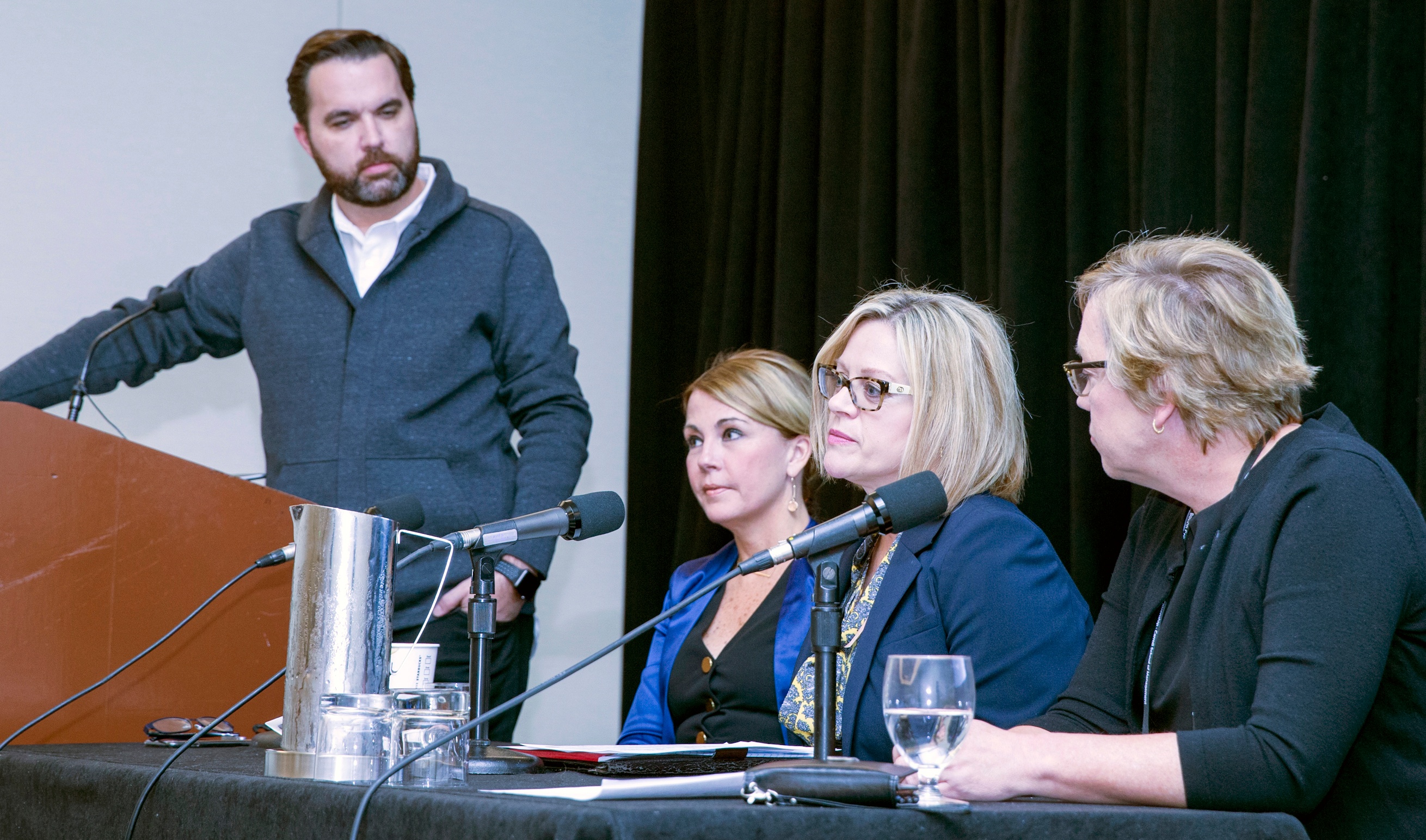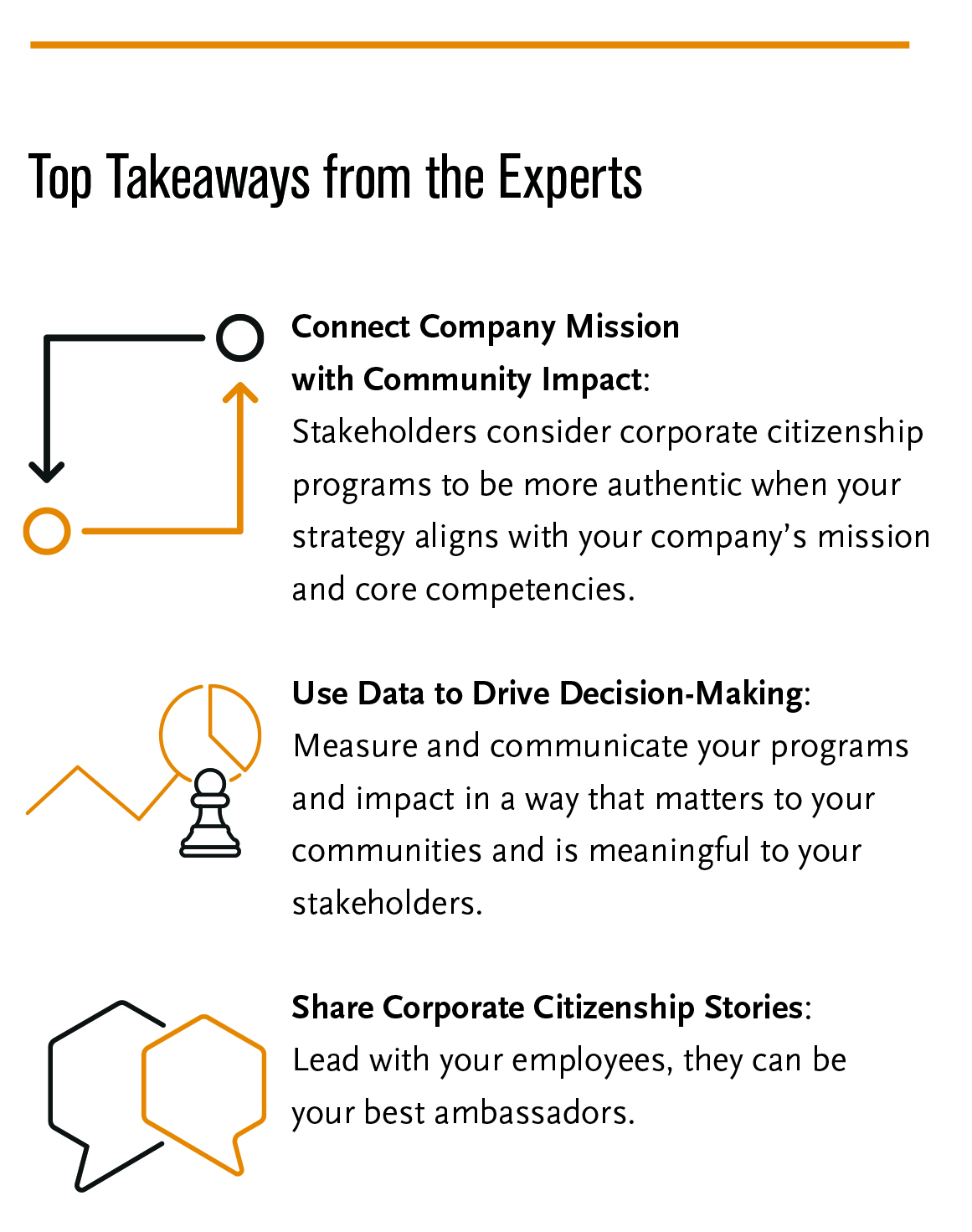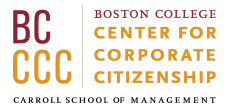3 ways corporate citizenship can improve brand and reputation
- Tue Nov 07 19:58:52 UTC 2017
- Patricia MacKenzie
Every year, the Boston College Center for Corporate Citizenship gathers 600+ CSR professionals together for its annual International Corporate Citizenship Conference. Some of the most popular aspects of this three-day event are the numerous breakout sessions, where attendees can learn from expert panels, practical workshops, and in-depth case studies. UPDATE: Save the date for next year's conference, hosted by Mary Kay, in Dallas, TX on April 28-30, 2019!
Below is a recap of a popular past session: Brand and reputation. You can find this story, and more, in our quarterly magazine, The Corporate Citizen.
 The interaction between a company’s bottom line, its environmental, social, and governance (ESG) efforts, and the way customers view both its product and its people is complex. Figuring out the right mix may be demanding at times. If you get it right, the rewards are more than worth the effort.
The interaction between a company’s bottom line, its environmental, social, and governance (ESG) efforts, and the way customers view both its product and its people is complex. Figuring out the right mix may be demanding at times. If you get it right, the rewards are more than worth the effort.
A company’s brand and reputation are important intangible assets with the potential to influence consumer perception, thereby increasing loyalty and purchase intent. They are important forces in attracting and retaining top talent, and—perhaps most importantly—they are major components of intangible value, which can account for up to 87 percent of market value.[i]
Corporate citizenship programs have an important role to play in delivering the benefits of strong brands and reputations. According to the Boston College Center for Corporate Citizenship’s 2017 State of Corporate Citizenship study, the number of executive respondents reporting success in meeting the key business goal of enhancing reputation nearly doubled when corporate citizenship efforts were integrated into business strategy.
During the Boston College Center for Corporate Citizenship’s 2017 International Corporate Citizenship Conference, Jorge Casimiro, vice president of global community impact and president of the Nike Foundation at Nike Inc., moderated a discussion between Patsy Doerr, global head of corporate responsibility, sustainability & inclusion at Thomson Reuters; Laura Freveletti, senior manager of corporate responsibility at Allstate Insurance Company; and Deb O’Connor, director of global corporate reputation and community relations at Whirlpool Corporation. Together, this expert panel elaborated on how to create, implement, and grow corporate citizenship initiatives designed to have a direct positive impact on brand and reputation. What follows is a condensed version of their conversation.
Connect Company Mission with Community Impact
Casimiro: At Nike, community impact is who we are; it is part of our culture—always has been—and it is part of our growth agenda. Our work in the community connects directly to Nike’s mission statement, which is to bring inspiration and innovation to every athlete* in the world (for us, *if you have a body you’re an athlete). We believe in the power of sport to do good in the world. To achieve our mission, we draw on our brands, our products, and the human potential of our people to unleash that community impact.
Doerr: At Thomson Reuters, we provide information to professional services. Because of the news-arm of our organization, we are very much wedded to our trust principles. We have a set of four or five that really guide the way we think about our brand and the way we think about our company. We provide information that’s entirely objective, so it’s critical that in every decision we make—when we’re putting data, analytics, or news out there, or working to lead the dialogue around sustainability, CSR, and diversity—that we’re really wedded to those trust principles.
Our corporate citizenship work is informed and driven from talent, customer, and investor perspectives. Through each of these channels, our efforts are linked back to who we are as an organization and to our trust principles. This is essential, because we’re invested in CSR because it’s the right thing to do, but also because it’s a business proposition. There is an impact on the bottom line.
O’Connor: At the Whirlpool Corporation, we’re a house of brands, so that means that each house does their own marketing and communications in their own world, yet efforts ultimately funnel toward broader goals. We’ve developed a strategy that brings together several different organizations to make a collective impact. For example, our Maytag brand is all about reliability and depend-ability, so they have partnered up with the Boys and Girls Club of America, and provide services to children and teens who rely on that club every single day. With our Whirlpool brand, there is a focus on caring for others, so Whirlpool created a program where they put washers and dryers into schools where there are a lot of kids in need.
Our strategy depends on our brand, our target audience, and who we’re talking to. These factors tend to be different within each corporate brand, and so each corporate citizenship initiative takes on a life of its own, though overall we focus on the same basic community needs: education, health and wellness, and access to housing.
Freveletti: At Allstate, our purpose is to help people realize their hopes and dreams by protecting them from life’s uncertainties and preparing them for the future. You’re in good hands … it’s the promise we make to our customers, and we work hard to uphold that every single day. We believe in good. So we did a ton of research to determine where it made sense for Allstate to invest to do the most good. And we came up with two programs—Good Starts Young, targeting the well-being and prosperity of our youth, and Purple Purse, focused on ending domestic violence. Each of those programs has evolved over the last 12 years, but remain true to Allstate, fulfilling our purpose to prepare and protect people from life’s uncertainties so they can achieve their hopes and dreams.
Use Data to Drive Decision Making
O’Connor: When faced with the challenge of creating buy-in, you have to ask yourself, ‘What’s in it for them?’ and then you have to go back to the data. If you’re talking to folks in marketing, the data should communicate how an initiative will benefit your brand. If you’re working with a team in HR, you determine what the data shows about increases to employee engagement—are employees staying longer at the company, are they more satisfied?
Freveletti: I think it’s important for all of us to be able to answer the ‘why’ question for all of our brands. For example, ‘Why youth empowerment for Allstate?’ To answer such questions, we conduct research so that we know which social issues are most important to our consumers, customers, employees, and other stakeholder groups. Then we can develop and enhance those programs, and communicate about them.
Several years of research with our stakeholder groups show that youth programs were of critical importance— so we developed youth programs that have evolved to stay relevant over time. We also learned that stakeholder awareness of Allstate’s community involvement makes a significant positive impact on our reputation, which in turn affects preference and choice. In fact, social value benefit can drive 18 percent of customer choice or about 40 percent of choice among traditional and social benefits.
Doerr: We recently engaged in an exercise where we took a look at all of the products we provide as an organization and we’ve associated each of them with a social value—what’s the impact that product X is having on the community? And, at the same time, what Sustainable Development Goal (SDG) is it associated with as well? It’s been really interesting—raising awareness of not just what we do as a business, but how what we do as a business really has an impact on the community.
What we’re finding is that our product owners and our salespeople love having this much broader conversation around the social impact of these initiatives and products. It’s not just about selling it, it’s about saying: ‘This is what Thomson Reuters does all across the board and what we provide to our community and to our world, and this is specifically the impact it has to society.’
Casimiro: I think that the time has passed when we had to make the business case for this work. The research is there. As we saw in the Boston College Center for Corporate Citizenship’s State of Corporate Citizenship 2017 report for this year, executives are more likely than ever to believe that companies involved with social issues need to increase the resources that they dedicate to this space. And more often than not, executives and boards are seeing this as a must deliver, not just as a-nice-to-do as it might have been seen 20, 30, 40, or 50 years ago.
Share Corporate Citizenship Stories
 O’Connor: In 1999, the Whirlpool brand created a relationship with Habitat for Humanity and to this day they still give a washer and dryer to every Habitat house that’s built in the United States and Canada. Habitat for Humanity has really become an employee engagement tool for us. I think that if we walked away from Habitat, half of our employees would walk away too.
O’Connor: In 1999, the Whirlpool brand created a relationship with Habitat for Humanity and to this day they still give a washer and dryer to every Habitat house that’s built in the United States and Canada. Habitat for Humanity has really become an employee engagement tool for us. I think that if we walked away from Habitat, half of our employees would walk away too.
We’ve worked with those who have benefitted to communicate the success of the program. We will still talk about it, but you have to watch the tone so that it’s not too boastful—we’ve found success in taking the stories of those we’ve impacted, as well as the results of our impact, and celebrating them collectively.
Doerr: We try to leverage storytelling. On our sustainability.com site, we provide research and articles on not only sustainability, but also diversity as well as community investment. To tell the fullest story, we offer both executive perspectives—CEOs, leaders, people who work in many of our partnership organizations—and those of our clients. This way, we’re not just telling our story, we’re telling it through their eyes. Similarly, we also have something called youth perspectives, where we interview young kids around the globe to tell their story and our story together at the same time. We’ve found that to be a useful mechanism that’s not so boastful, but really gets inspired stories out in the community.
Casimiro: Brands by nature are commercial, and on the commercial side they are meant to be boastful when they advertise (e.g., we’ve got the best analytics, the fastest shoes). One of our strategies is to elevate the work of our partners and to share the work we’re doing together while playing to our company’s strengths and what we bring to the partnership.
I think the other voice to leverage is that of your employees—our employees are our brand. More than half of our employees at Nike are retail employees. The closest we come to speaking to consumers is speaking through our employees—they are the personification of the Nike brand. When it comes to sharing our work, we lead with our employees, because if they don’t know about it, it only gets harder to share that story with external stakeholders. The employees have to know about it first, which provides an opportunity to get direct feedback on what works, which areas resonate most, and whether our messaging is delivering against the impact of the work.
Freveletti: Allstaters, as we affectionately call our agency owners and employees, are eager to get involved in our signature social impact programs and in general volunteering. As soon as they’re engaged, they become our ambassadors of “good.” We leverage stories of Allstaters “bringing out the good” in their local communities through our internal publications and external media of all kinds—earned, paid, traditional, and social—knowing the positive impact awareness of our community involvement has on our reputation.
Business is about relationships. And, as our Chairman and CEO Tom Wilson says, “people do business with you because of what you do, not what you sell.” Our customers and employees care about how we show up in society. Which means we need to deliver goods and services, employment opportunities and business results—all while doing good, too.
[i] Ocean Tomo (2015.) Intangible asset market value study. Retrieved from http://www.oceantomo.com/intangible-asset-market-value-study/
Save the date for the 2019 International Corporate Citizenship Conference—hosted by Mary Kay—in Dallas, TX on April 28-30, 2019.
